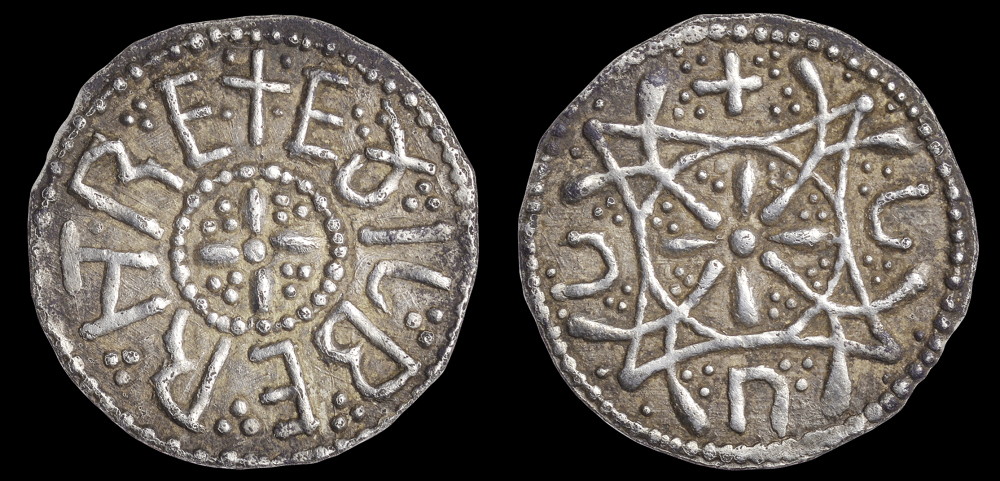Article

12 June 2014
A unique Anglo-Saxon silver penny which provides a clue to the murder of a saintly East Anglian king by a neighbouring monarch has sold or £78,000 at auctioneers Dix Noonan Webb. Found in a Sussex field by a metal detectorist, the 1,200 year-old coin had been estimated at £15,000-20,000.
Darrin Simpson, a 48 year-old pest control specialist from Eastbourne, Sussex, was hurrying to shelter from a hailstorm in early March when he picked up a signal on his detector. Despite the appalling weather he stopped, dug down 6-8 inches and found the penny, minted during the reign of Æthelberht II and identified by experts as the only one of its type ever discovered.
“There was fierce bidding for this unique coin,” said a DNW spokesman. “The price paid shows that the worldwide market for important pieces like this Æthelberht II coin is extremely strong.” Bidders in the room, on the internet and those who had lodged advance commission bids pushed the price up rapidly from its £17,000 starting point. The final hammer price was £65,000 and by the time buyer's commission was added the winning bidder paid £78,000.
Mr Simpson, who has been a metal detectorist for 12 years, had been working his way across the unidentified site in Sussex for about an hour when he was caught in the hailstorm. As he moved quickly, planning to take shelter under some trees, he got a signal similar to others he had picked up that day. As they had all turned out to be Second World War era .303 bullet cases, he was not optimistic as he stopped to dig.
“I thought it was a Saxon coin, the first one I had found, and I was very happy about that,” said Mr Simpson. It was not until he contacted the Early Medieval Corpus of Coin Finds at the Fitzwilliam Museum in Cambridge that he realised the full importance of his discovery. “It was a bit of a shock really, I couldn’t sleep for two nights after it was identified,” he said. “The condition is really good. This is a unique coin. I doubt if I will ever find anything better.”
The coin is only the fourth ever found from the reign of Æthelberht II, a shadowy figure who ruled East Anglia in the late 8th century. The other three are all in museums and have a different design. The coin found by Mr Simpson is the first to have Æthelberht’s name and the title REX on the same side.
“This new discovery is an important and unexpected addition to the numismatic history of 8th century England,” said Christopher Webb, head of the coins department at Dix Noonan Webb.
Little is known about Æthelberht II’s reign but stories about his piety and his gruesome end ordered by Offa, king of neighbouring Mercia, have survived down the centuries. His reign over the kingdom of East Anglia is thought to have begun in 779. Fifteen years later in 794 he reluctantly agreed to marry Eadburh, Offa’s daughter, and set off to visit her at the Mercian king’s villa at Sutton Walls in Herefordshire.
Offa’s queen Cynethryth persuaded her husband to have their guest killed and Æthelberht was seized, bound and beheaded. According to medieval legend, Æthelberht’s severed head later fell off a cart and, after being found in a ditch, restored a blind man’s sight. The dead king was declared a saint and became the focus of a religious cult in East Anglia. Many parish churches in Norfolk and Suffolk are still dedicated to him.
The coin auctioned at DNW may have been one of the reasons for Æthelberht’s terrible end. The East Anglian king is believed to have struck the other three known coins from his reign with the approval of his much more powerful neighbour Offa. However the newly-discovered penny looks like an act of defiance by the increasingly ambitious Æthelberht.
The fact that Æthelberht’s name and the title REX (King) appear on the same side of the coin may have demonstrated a degree of independence that was simply too much for Offa and Cynethryth to bear and they decided to kill him. How this penny came to be in a Sussex field will never be known but its discovery by Mr Simpson provides us with a possible motive for a 1,200 year-old Anglo-Saxon royal murder.
Share This Page